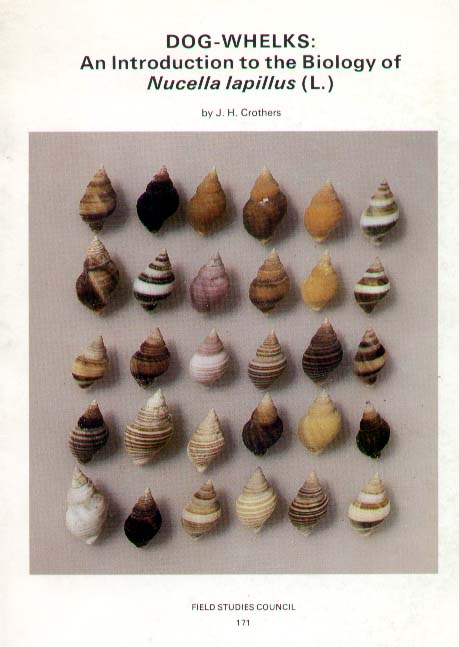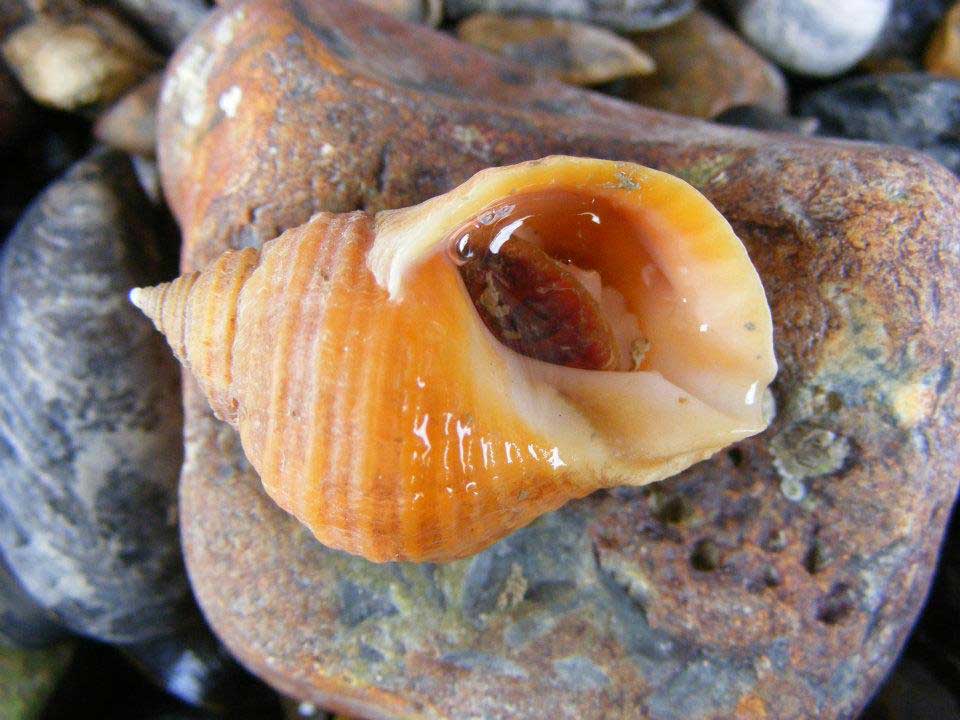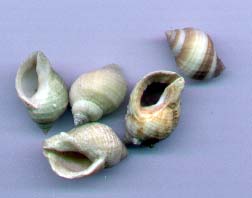
 |
Dogwhelks
Dogwhelks, Nucella lapillus, are one of the commonest gastropod molluscs on the shore of the North Atlantic, found on rocky shores all around the British Isles, and from the Arctic south to Gibraltar, and on American side as far south as Connecticut. They do not seem to be found in the Mediterranean Sea. They should not be confused with the larger Edible Whelk, Buccinum undatum, which is only rarely found between the tides.
Predators
Dogwhelks are often a dirty
grey, but they can be found in a variety of colours including all white,
which is quite common, orange, which occurs often in certain localities,
brown, purple, and striped varieties. Dogwhelks
are
active predators, preying on acorn barnacles
by smothering them, and on mussels by boring
a hole in the shell and sucking out the rich orange flesh..
In pollution-free areas,
their yellow egg capsules can often be seen in crannies amongst the rocks
and on pier supports. Hundreds of the adults are also likely to be present.
The young hatch as miniature counterparts of the adults without a
planktonic stage.
Study
Because of their widespread occurrence and prevalence, they have attracted many studies, including the various shapes of their shells according to environmental conditions on the shore.
 The
Field
Studies Council publish an AIDGAP
guide to Dogwhelks.
The
Field
Studies Council publish an AIDGAP
guide to Dogwhelks.
This book contains comprehensive references.
Field Studies Council Publications
The Field Studies Guide by J.R. Crothers (see page 35) is essential
reading for the serious rockpooler. The "teeth" in this species is the
knobbly bits in the aperture and not the radula used for feeding.
Their size is reported as
up to 40 mm, but they attain much larger sizes than this, at
least up to 60 mm.
Offshore Reports
My impression is that you see Dogwhelks subtidally in rocky areas exposed to strong tidal streams (places where currents exceed 5 knots at the surface) and where there is a plentiful supply of food, barnacles. One of the places where they are most prolific is the Falls of Lora at the entrance to Loch Etive near Oban. You can (well, could when I dived there many years ago before TBT) also see them in the narrowest parts of the Menai Strait. Otherwise, in my view, it would be exceptional to see them subtidally.
by Keith Hiscock (JNCC)
I have seen Dogwhelks just twice when diving, - which is very rarely, though I would not necessarily have recognised it in the first few years.
Once in August in the Farne islands, where we saw perhaps ten or a dozen at about 6 metres, and a few below, the deepest at 11 metres. They were live and active, with the shells about 25 mm long. No egg capsules were present.
Strong Tidal Streams
The second time was in May,
off Anvil Point, Isle of Purbeck, Dorset, on the remains of a mussel bed
at nearly 20 metres in strong tidal streams.
Nucella was the dominant
mobile species; large (50 mm) shells were typical and some were larger.
They were breeding; we saw
at least two groups, each of about eight in an untidy pile next to a clump
of close-packed egg capsules - I counted one clump as about 100+ capsules
in an area roughly 30 cm by 10 cm. Elsewhere there were occasional
groups of old capsules,
in one case with several sets of new ones laid in groups around its edge.
The Sting Winkle, Ocenebra
erinacea, and its egg capsules were also present, but in smaller numbers.
by
Jane Lilley
Dogwhelks,
Nucella
lapillus, feeding on a Mussel, Mytilus edulis
Dogwhelks from around the British Isles.
 |
Dogwhelks are a popular mollusc for intertidal studies. This is because they are a predatory gastropod usually only found between the tides, and also because they exhibit variations in form (different morphs) that can be easily observed. Colouring is variable in Dogwhelks, with dirty purple, white and orange specimens being most noticeable and with banded specimens occurring on some shores. The illustrated orange and white specimens have been noted before (by myself and others) on exposed coasts where mussel beds are not predominant. What is unusual about the illustrated finds are the raised ridges (=cords) and pimples on this shell. Most Dogwhelks are smooth shelled, or with cords without pimples, but even more pronounced overlapping ridges (=tiles) occur called var. imbricata. The colour and morphical variations are put down to environmental influences (and possibly genetic variations) like the availability and types of food (the usual diet is mussels and barnacles), the degree and type of shore exposure, biogeographical distribution and sea temperature, absence or presence of predators etc. | |
| Dogwhelk
Nucella
lapillus
The photograph on the right is a Dogwhelk from the Sussex shore with the raised cords but not the pimples. Hard
substrate is hard to find on the Norfolk coast, here animals have colonised
sea defences.
Report and Photograph by Tabitha Pearman (Rainbow Nature) on flickr |
 |
Hey,
I am a student doing oceanography with marine biology and at the moment i am doing a project on Dogwhelks. I was wondering if anyone would be able to help me with some info on them:
How do Dogwhelks differ from each other from those living on an exposed rocky shore to those living on a sheltered rock? This is to do with their shell shape and size and the size of the aperture.
How do they also differ up the shore (i.e. low, middle and upper) on a) exposed and b) sheltered shores.
I would really appreciate the information, so if you do know could you e-mail on dappy@scubadiving.com.
Thank you,
Eve
Reply-To: <dappy@scubadiving.com>
Hello Eve and others,
Dogwhelks, Nucella lapillus
We welcome newcomers and relative novices to our group. However, you must appreciate, we cannot do all your basic research. You may have got lucky and found somebody who is also doing Dogwhelks to compare experiences.
Otherwise look for:
dogwhelk.htm
exposure.htm
If the information you asked for is not in the books on these pages, I would be interested to know.
Dogwhelks, Nucella lapillus, are present throughout out the year, so you can do down and compare them first hand. There are no private property interests to worry about on the shore, so it is an ideal location for first hand study in the wild.
If you are planning a long trip down to the coast, and need advice on the prevalence of dogwhelks before making a trip, we may be able to help out, or even supply a live dogwhelk by snail post (I couldn't resist that one!)
Cheers
Dear Eve,
I have recently been working with some students
on this same idea on an undergraduate field course. They got some
ideas and references from the textbook by Little and Quitting (Ecology
of Rocky Shores - I think). There is
a description of work done on the shell shape and thickness of Nucella
on different shore types. It would be a good starting point to look
here then
work through getting papers that way.
I hope this helps
Tammy
-----------------------------------------------------------------
Tammy Horton
School of Animal and Microbial Sciences
The University of Reading
Whiteknights, PO Box 228
Reading RG6 6AJ
tel:(0118) 9875123 ext. 7063
Fax:(0118) 9310180
t.horton@reading.ac.uk
Hello, Eve, Tammy & others,
You probably mean the book Intertidal Ecology, page 170-1. See the following web page:
school-5.htm#Intertidal
Cheers
Andy Horton
British Marine Life Study Society
EMail:Glaucus@hotmail.com
 Hello,
Hello,
Nucella lapillus
There is only a brief mention in Intertidal Ecology, and it is the Crothers Guide that is the one to read.
No need for snail post, pictures can be sent by eMail.
These gastropods can be scanned in on a computer scanner, so what readers could do on a winter's night is scan in their local examples of Nucella apertures. But a digital camera is better for shell collectors. I am apt to collect a particularly colourful one on shore visits, although at Kingston Beach, Shoreham-by-Sea, Sussex, they are only just returning after being absent from 1971 to 1997.
Once upon a time I measured these dogwhelks and I remember one in 100 was larger than the normal maximum length.
Behaviour in Captivity
In aquaria, I could not get them to eat the limpets, Patella. At Felpham, in Sussex, they occur in small numbers where there only food is Acorn Barnacles and Grey Topshells, Gibbula cineraria. All these specimens are white (do not make the assumption the colour depends on what they eat though?), and some of them all orange as well (a long time ago).
When mussels bore into dogwhelks the natural response
of Mytilus edulis is to send out its foot
to lay more byssus threads. If a dogwhelk gets trapped, it is by accident!
There is a photograph
Cheers
Andy Horton
British Marine Life Study Society
EMail:Glaucus@hotmail.com
Hello,
I have managed to get the books mixed up somehow.
BIOLOGY OF ROCKY
SHORES
Little & Kitching
is a relatively recent book (1996 reprinted 1998), with details at:
I do not seem to have a copy of this in my Library.
Cheers
Andy Horton
British Marine Life Study
Society
EMail:Glaucus@hotmail.com
The paper mentioned in the section on Nucella shell shape and thickness is by Gibbs, P.E. (1993) in the Journal of Molluscan Studies.
Hope this helps
Tammy Horton
BIOLOGY OF ROCKY
SHORES
Little & Kitching
Dogwhelks begin on page 140, and it seems to contain a few later snippets of interesting information not included in the Crothers book.
Andy Horton.
Another ref:
Physiological variation in the dog-whelk Nucella
lapillus, L. either side of a cline in allozyme and karotype
frequencies
RICHARD R KIRBY, BRIAN L BAYNE
Biological Journal of the Linnean Society (1994), 53: 277-290.
The Journal
of the Marine Biological Assoc. the UK has several papers on Dogwhelks.
You asked if divers ever see Nucella lapillus
I have seen it, but only twice - which is very rarely, though I would
not
necessarily have recognised it in the first few years I was diving.
Once in August in the Farne islands, where we saw perhaps ten or a dozen
at
about 6 metres, and a few below, the deepest at 11 metres. Live and
active,
shells about an inch long. No eggs.
The second time was in May, off Anvil Point, Isle of Purbeck, Dorset,
on the
remains of a mussel bed (in agreement with comment in message 487)
at nearly
20 metres in strong tidal streams. Nucella was the dominant
mobile species,
and 'very large, 2" inch shells typical and occasionally larger'. They
were
breeding; we saw at least two groups, each of about 8 dogwhelks in
an untidy
pile next to a clump of close-packed egg capsules; I counted one clump
as
about 100+ capsules in an area roughly 10 inches by 3. Elsewhere occasional
groups of old capsules, in one case with several sets of new ones laid
in
groups around its edge. Ocenebra erinacea and its egg capsules
were also
present, but in smaller numbers.
I would also like to know if other divers have seen them, and if so,
where.
Since they can live down to 20-odd metres, it seems surprising that
they
aren't more common. Or am I regularly overlooking them?
Jane Lilley
Hello,
Dogwhelk,
Nucella
lapillus (more observations requested)
An article(s) on these gastropod molluscs is planned for the next issue of the journal Glaucus. Most of the research and one of the articles has already been undertaken, but because these gastropods are only slowly recolonising areas after being wiped out in harbours and estuaries because of TBT pollution, I would be interested in updated observations from around Britain. There is other information like the size, eggs present, whether they have teeth (knobbly bits on the shell aperture) and sizes and colours, prey, that are all of interest with this invertebrate animal.
e.g.
At Kingston beach,
Shoreham-by-sea, (TQ 235 048) there are extensive mussel beds in the sheltered
entrance to the harbour. Dogwhelks disappeared in 1981, and returned in
small numbers in 1997. Year 2000: the adults are frequently (10-50) to
be found, but there are no sign of eggs, which were not recorded from 1979
to 2001, and may have been absent prior to that as well.
This is not a very good dogwhelk site because
I have not got any records of breeding populations before 1979 and after
that no breeding has been recorded.
The best observations would be on sites where they were previously recorded breeding, but ceased (e.g. the pier outside the MBA lab at Citadel Hill?). I know the Marine Conservation Society sent out a lot of Report Forms (I filled some in myself) but I do not what happened to them or if a report on the findings was published.
Do divers ever see this species in deeper water?
Is there are any correlation between the position on the shore and the size and shape of Nucella lapillus? (from observation).
Some students may have also done a college thesis on this gastropod, so I would be interested in hearing from them.
For descriptions of prevalence, numbers are best, but failing this, the ACFOR system is standard for rockpooling reports in Glaucus:
SUPERABUNDANT = 10,000 +
ABUNDANT 1000- 10,000
COMMON 100-1000
FREQUENT 10 - 100
OCCASIONAL 2-10
RARE = ONLY 1
in a single shore visit.
NEW ACFOR SYSTEM OF ABUNDANCE OVER A SPECIFIED
AREA (OF SHORE)
BMLSS SHOREWATCH BIOLOGICAL RECORDING 2000 SYSTEM
ONLY
SUPERABUNDANT = 10,000 +
ABUNDANT 1000- 10,000
VERY COMMON = 500-1000
COMMON 100-1000
VERY FREQUENT = 50-100
FREQUENT 10 - 100
OCCASIONAL 2-10
RARE = ONLY 1
 There is an overlap because if writers are using the old standard system,
confusion could occur.
There is an overlap because if writers are using the old standard system,
confusion could occur.
URLs
Dogwhelks:
dogwhelk.htm
Glaucus:
Glaucus.htm
Cheers
Andy Horton.
British Marine Life Study Society
----------------------------------------------------------------------
GLAUCUS HOUSE : 14 CORBYN CRESCENT : SHOREHAM-BY-SEA
: SUSSEX : BN43 6PQ
Tel: 01273 465433 EMail:
Glaucus@hotmail.com
----------------------------------------------------------------------
====================================
http://www.smartgroups.com - making online groups
happen
My impression is that you see
dogwhelks subtidally in rocky areas exposed to
strong tidal streams (places where currents exceed
5 knots at the surface)
and where there is a plentiful supply of food,
barnacles. One of the places
where they are most prolific is the Falls of
Lora at the entrance to Loch
Etive near Oban. You can (well, could when I
dived there many years ago
before TBT) also see them in the narrowest parts
of the Menai Strait.
Otherwise, in my view, it would be exceptional
to see them subtidally.
TBT & Imposex
This is going back quite a long time (over 30 years?), but still within living memory.
Who should be given credit for discovering the link between Tributyltin and the imposex phenomonem (although it may have not be called this then) in gastropods in the family Muricidae, notably Nucella lapillus in the NE Atlantic, and others in the Pacific., and possibly other families as well.
I have some early references:
BLABER, S.J.M 1970 The occurrence of a penis-like
outgrowth behind the right tentacle in spent females of Nucella lapillus
(L.).
Proceedings of the Malacological Society of London,
39, 231-233.
I have not read the paper though.
SMITH, B. S., 1981. Male characteristics on female
mud snails caused by antifouling bottom paints.
Journal of Applied Toxicology, 1, 22-25.
I have not read this paper either.
If anybody needs a photograph (for a presentation on a computer etc.) of Nucella lapillus, I have uploaded one with a few notes (including the details of the Crothers pamphlet) at:
dogwhelk.htm
It shows as Nucella lapillus bores into Mytilus edulis, the brown foot of the mussel is extruded. This was tested on about 5 occasions and happens readily when under attack. The image is not clear enough for publication.
I am editing an article for Glaucus on Nucella lapillus, so if anybody has any observations of this mollusc they want to include, I would be interested to hear from them. Dogwhelks are only just now returning to some British shores.
This is not a peer reviewed journal, but more of a popular one, although dogwhelks have never really been popular fare.
My observations seem to indicate that where Carcinus maenas is common, the recolonisation is hindered by predation on the small dogwhelks, but the dogwhelks disappeared in 1981, and it was too long ago for me to know what the age (size) distribution was before they disappeared.
Cheers
Andy Horton
British Marine Life Study Society
EMail:Glaucus@hotmail.com
(EMail messages are not monitored by third parties.)
British Marine Wildlife Forum (commenced 1 August
2000)
Group Home: http://uk.groups.yahoo.com/group/Glaucus
Trouble with Dogwhelks
Report from Sussex 2002
|
|
|
|
|
News 2018 |
Membership Form |
|